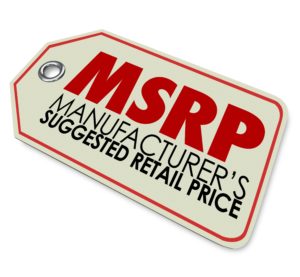The following excerpt is from a recent webinar featuring Robert Rose and Tom Martin on the challenge marketers face today in connecting with self-educating buyers. Robert Rose is the chief strategy officer with the Content Marketing Institute and the author of a new book called Experiences, the Seventh Era of Marketing. You can connect with him on Twitter here: @Robert_Rose. Tom Martin is an internationally recognized digital marketing keynote speaker, blogger, founder of Converse Digital, and author of The Invisible Sale, Tom combines his two passions, marketing and technology, to teach companies how to leverage digital marketing channels to achieve sustained sales growth, enhance brand perception, and prospect for new customers. You can follow him on Twitter at @TomMartin.
 Robert Rose: Today we’re going to learn how to leverage the 100–year-old science of “relationship formation” to win the attention of today’s buyer. We’re going to learn about the funnel optimization and how combining static and dynamic funneling will lead prospective buyers into that next stage of your content. And we’ll learn how to use first-click and second-click content, what those actually mean, and how they provide your buyers with the best information. And to help us do that is somebody that I’ve known for some time, Tom Martin. I have to say, he and I sort of go back and forth on who’s got the better FM radio voice here. Tom, take this away.
Robert Rose: Today we’re going to learn how to leverage the 100–year-old science of “relationship formation” to win the attention of today’s buyer. We’re going to learn about the funnel optimization and how combining static and dynamic funneling will lead prospective buyers into that next stage of your content. And we’ll learn how to use first-click and second-click content, what those actually mean, and how they provide your buyers with the best information. And to help us do that is somebody that I’ve known for some time, Tom Martin. I have to say, he and I sort of go back and forth on who’s got the better FM radio voice here. Tom, take this away.
 Tom Martin: Well, first of all, there will be a vote at the end of this webinar about who has the best FM radio voice. The winner will receive a free copy of mine and Robert’s book.
Tom Martin: Well, first of all, there will be a vote at the end of this webinar about who has the best FM radio voice. The winner will receive a free copy of mine and Robert’s book.
Robert Rose: [LAUGHTER] Start the hashtag now.
Tom Martin: Yeah, exactly. Okay, let’s start out with really defining the self-educating part of it. To me that’s the real strategic shift. You have to change to a propinquity mindset in order to compete today.
What do I mean when I say self-educating buyers? Well this is, to me, probably the most interesting marketing trend that I’ve watched in my career. And it definitely goes back probably at least a decade or more. I saw it first really emerge in the automotive industry. Think about how you maybe bought your first car. You went in, the dealer told you what they would sell you the car for, and you basically began to try to haggle the price down, and get them down as far as you can.
Back maybe about 10 years ago, things changed. The Internet came about and all of a sudden, for the first time, we as buyers could see online how much that dealer paid for that car, what was the invoice, not the MSRP. And you can even start to see things like dealer holdback, specials, and all these bonuses and extra things that they could qualify for if they sold so many cars this month. There was all this information that dealers traditionally had, that was about where their profit came from when they sold a vehicle. But we as buyers never had that. Well, all of a sudden, the Internet gave us access to that. And then we became educated buyers.
So guess what? When you went in to buy a car, you didn’t start at MSRP, you would walk in and you’d hand the dealer the paper and say, “well this is what you paid, these are your discounts. So let’s start down here at this price and you try to negotiate me up instead of me negotiating you down.” And that’s really where the dynamic changes. The power shift that occurred in automotive 10 or 15 years ago has now moved through virtually every category of work that I’ve worked in in the last 10 or 15 years, to where now even the most vertical and mundane of categories have self-educated buyers.
The Invisible Sale
Whether you look at pretty much any research that you can find around, you’ll find two numbers that tend to keep popping up. So you’ll find a number that says about 70 percent of buyers, whether you’re in the consumer space or B2B or whatever, about 70 percent of buyers are researching brands, companies, people, whatever the case may be, before they bother to identify themselves as in the market for that product or service.
 Further, if you’re in an environment, like a B2B environment where it might be an RFP-type environment, or where buyers will form a short list (and those are the people that really engage deeply with a sales process), you’ll find various different research resources. They’ll all kind of finish up in around the 50 percent number range. And I’d say 50 percent of buyers are getting all the way to that short list before they raise their hand and identify themselves.
Further, if you’re in an environment, like a B2B environment where it might be an RFP-type environment, or where buyers will form a short list (and those are the people that really engage deeply with a sales process), you’ll find various different research resources. They’ll all kind of finish up in around the 50 percent number range. And I’d say 50 percent of buyers are getting all the way to that short list before they raise their hand and identify themselves.
And as a guy who grew up in the ad industry, which is an RFP-short-list-driven sales process, that number scared the hell out of me the first time I saw it. And it should scare anybody in that kind of an industry as well. Because what this number really is saying to you is that if that’s in fact true, if 50 percent of the people are getting all the way down the short list before they bother to tell anybody they’re buying, that means that you could be losing upwards of 50 percent of your sales – and you don’t even know it. It’s not going to show up in your CRM. It’s not going to be in a sales loss report. Because you never knew there was a sale to win. And that’s a really eye-opening experience.
The Invisible Buyer
Because what it means is that we’re dealing with: A buyer that’s largely invisible. I cannot tell you how many clients I’ve worked with where I’ll hear some conversation about how the sales cycle is shortening. Years ago we would have 120-day sales cycle. Now it’s 30 or 40. The sales cycle is not shortening. I hate to burst people’s bubble. It’s just becoming more and more invisible, as are buyers, as they hide behind the anonymity of a Google search, or behind finding freely available digital content. Because it used to be that if you wanted content or information, you had two resources: You had us: the marketers, the brand. And then maybe you had magazines. And you probably subscribed to that magazine. And so at least I could pull your name off a subscriber list – I could identify you.
But now you can go all over the Internet and there are blogs, and websites, and social media – all these places where you can get information, and you’re completely anonymous to the person who produces information. And that is the strategy inflection point. That is the real scary part of the self-educating buyer. And it’s this reason why I feel like you really have to change the ballgame a little bit. You have to come at it differently. I’m not alone in that. I think a lot of people over the last say, five years, say that we’ve seen a number of really big shifts, and there are a lot of people talking about how we need new strategies to combat this.
Strategies, Not Tactics
Inbound marketing. Huge, right? In the last five years maybe you’ve heard and read so much about inbound marketing. And so many people are positioning that as sort of the silver bullet that fixes everything. Win the Google search, win the inbound, and you’ll win the day. And there are many companies who have built their entire companies using inbound marketing. Content marketing. Hey we’re all here, right? We’re not on a Content Marketing Institute webinar for nothing. Content marketing is huge. And makes perfect sense when you think about it. Because a self-educating buyer, what are they educating with? Content. And so certainly content marketing – there’s a big bucket of effort going behind that.
And then the newest kid on the block, social selling. In about the last year you’ve seen people really glom on to social. I’ve been called so many times in the last year with companies wanting us to conduct social selling workshops or speak at their conference about social selling. But social selling, content marketing, inbound marketing: None of those are strategies. They’re all tactics. Just like television advertising, email, direct mail, PR, events. They’re tactics. They’re not the silver bullet. You have to combine them all together under a cohesive strategy. A go-to-market strategy that really will deliver today’s self-educating buyer to your doorstep. Because that’s the goal. That’s where you win.
Propinquity
 Well for me, propinquity is that strategy. It’s an actual scientific theory that has been researched repeatedly over the last 100 years, to where it’s now an accepted social science law. And what it basically says in English is that the greater the physical or the psychological proximity between people, the greater the chance that they’re going to form a friendship or romantic relationship. In fact, most of the research that you see in this space over the last 100 years is so that people can understand how human relationships form, specifically romantic relationships and friendships.
Well for me, propinquity is that strategy. It’s an actual scientific theory that has been researched repeatedly over the last 100 years, to where it’s now an accepted social science law. And what it basically says in English is that the greater the physical or the psychological proximity between people, the greater the chance that they’re going to form a friendship or romantic relationship. In fact, most of the research that you see in this space over the last 100 years is so that people can understand how human relationships form, specifically romantic relationships and friendships.
But in studying that science, what we start to see is that the same principles by which human relationships form, hold true when you look at how you form relationships with brands and products and services. Now as I said, there’s been a lot of research done in the last 100 years. My favorite study to discuss, because I think it really drives this point home better than anything, is a study (The Westgate study) that MIT did on a student housing complex in Boston in the 1950s. I like it because the housing complex itself was two stories, eight units on the front, eight on the back. So 32 units. So by definition you got a lot of proximity there. This isn’t some huge apartment or complex. It’s a pretty small confined building.
The scientists looked at, from the beginning of the school year to the end who became best friends. Who are the BFFs, where do they live? And what they found is that in this really small, highly proximate environment, that even a little bit more proximity made a meaningful difference. And that little bit of proximity was at the end of the year the best friends tended to live next door to one another. If they didn’t live next door to one another… one of them lived next to the stairwell.
Shift that little bit of proximity and it made a difference. And that’s what really drives this home because what we have in a propinquity environment is that the goal in that little proximity, the reason that worked in the MIT study, is because if I’m leaving my apartment and you’re leaving your apartment at the same time, we’re both going to class, we’re probably going to walk next to each other, we’re going to get to talk, to bump into each other more often, and we’re going to get to know each other a little bit.
And it’s proximity that creates that. And the more you can create those little bumps, the more you can actually move somebody through the propinquity pathway, which we’ll talk about in a second.
Creating Propinquity for Your Brand
So how does this work in marketing? Every single prospect for your product or service, is surrounded by propinquity points. That includes searches, Google, Yahoo, etc., where they’re actively seeking information. Definitely through social media.
They’re talking to people offline and via email and phone. And then increasingly you’ve seen the use of digital website content where they can educate and self-educate and get ideas. For anything you buy in the world, there are a set of propinquity points that surround you. You can be passively or actively targeted by brands and companies.
And that’s where this whole relationship process and this philosophy and this law of propinquity translates into a macro marketing strategy. How do you define these propinquity points? Then how do you surround that prospective customer or groups of prospective customers so that you create that increasing level of bump? That proximity is what allows that customer to move through what is called the propinquity pathway.
And so we move through four simple steps:
Aware > Know > Like > Buy
Certainly it’s more complex than this. I’ve oversimplified it for the purpose of the webinar. The first time you come into contact with something you become aware of it. That makes sense. The more you come into contact with it, people for instance, think of this in terms of dating (that seems to be an analogy that works for a lot of people). So the first time you meet somebody, you’re interested, and you become aware of them, maybe you date. Well what are you doing while you’re dating? You’re getting to know each other. You’re getting to know each other and hopefully you find that as you get to know each other better, you like the person. And if you like them enough, you sort of take the ultimate propinquity plunge. You get married, or in the case of a brand – you buy.
And so what we have to do is move people methodically through this pathway. And so how does that work? Well let me give you an example of how the propinquity pathway moves.
So everybody today that’s on this webinar, you’re now aware of Tom Martin, you’re now aware of Converse Digital, and you’re becoming aware of propinquity and the ways that I approach marketing and sales. If this is it, if you never talk to me again, you’re going to leave and you’re going to know a few things about me, a few things about my company. But let’s say you come to Content Marketing World and you see on the agenda that Tom Martin is speaking, which I will be by the way. And you say, “Hey, that was actually a pretty good webinar, he was pretty good, this is a slightly different topic, I’m going to go listen to him instead of Robert Rose because he has a better FM voice.”
And you’re going to come to that conference session. You’re going to learn a few more things. So now you’ve got what you learned here, what you learned there. Maybe you get so frickin’ excited and you’re so fired up, you order my book from Amazon and buy it, and you actually read it.
And after you read that, because it’s so awesome (my mom says it’s the best book she’s ever read in her entire life, and she’s not even a marketer, so imagine how much you’ll like it), you’re going to sit there and go, “wow, he’s so great, I’m going to sign up for his blog.” Well if I can get you into my blog, well now you’re going to get touched 30, 40, 50 times a year. And each time you’re going to get new knowledge about me, about my company, about things we do, about how we approach marketing and sales.
And all of these times you’re getting little knowledge points, just like we’re dating. That’s the beauty of getting someone to sign up for a blog. When they sign up for your blog, it’s like they’ve agreed to date you. And what happens is mathematics takes over. Because after you’ve created this huge data set of knowledge points, because they consistently run into you, because I’ve created this propinquity with you. The theory is you’re ultimately going to take that propinquity plunge. When you need digital strategy or a keynote speaker, you’re going to remember me, you’re going to like me, and you’re going to hire me. That’s how it works.
![]() Watch the webinar to get the whole story on connecting with self-educated buyers, including the basics of funnel-optimized website design and ways to use first-click and second-click content to get your prospects to convert.
Watch the webinar to get the whole story on connecting with self-educated buyers, including the basics of funnel-optimized website design and ways to use first-click and second-click content to get your prospects to convert.
